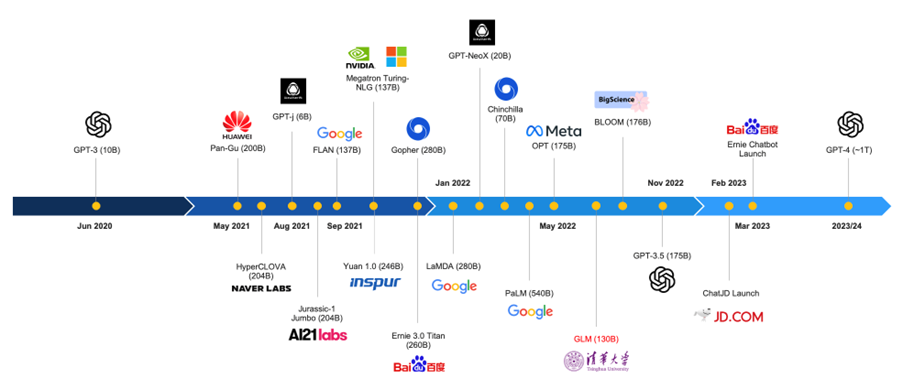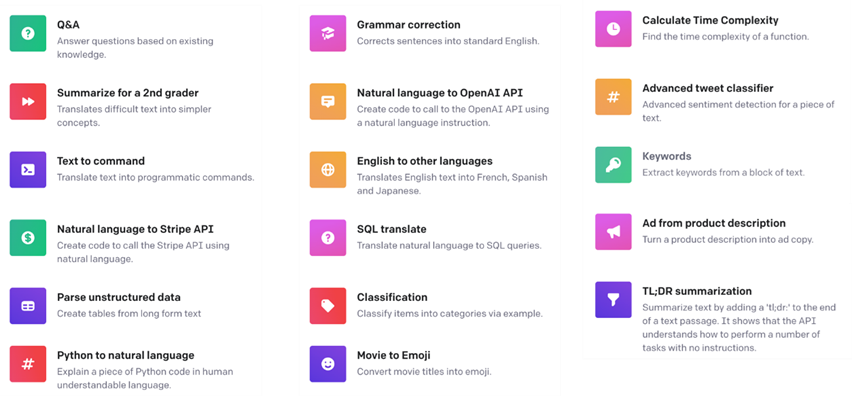China's Generative AI Dilemma: Innovation vs. Control
By IoT ONE, with input from ChatGPT.
The advancement of generative AI has created a frenzy among Chinese businesses as they explore its potential impact on internal operations and customer interactions. OpenAI, the company behind the GPT-3 algorithm that powers ChatGPT, Whisper, and DALL-E, ignited this frenzy with these applications, demonstrating the capabilities of GPT-3 in processing and generating text, audio, and images. However, real innovation is happening beneath the surface, with thousands of developers exploring ways to leverage GPT for process restructuring and new customer experiences.


OpenAI’s applications face adoption challenges in China by both regulators and OpenAI. Access to ChatGPT and third-party applications powered by the service was initially available but was later blocked by China’s Internet firewall in February. Beijing regulators also instructed technology companies to bar access to services enabled by ChatGPT, citing concerns of potential propaganda use.
On the other side, OpenAI has also restricted access in China due to conditions that the company claims “make it difficult or impossible for us to [provide access] in a way that is consistent with our mission.” OpenAI likewise bans access to the application in Hong Kong, Iran, Russia and parts of Africa. This stance is unlikely to change since it is rooted in a well-defined set of company values.
The Microsoft Enterprise edition of GPT might just have the solution for the Chinese market. The enterprise API is powered by the same AI model behind ChatGPT, known as “GPT-3.5-turbo”, and is hosted on Microsoft Azure. It is priced at $0.002 per 1,000 tokens (about 750 words) and provides an affordable and high-powered platform for building enterprise-AI applications. According to Microsoft representatives, the enterprise API can serve the Chinese market by operating in the backend, but it cannot yet be deployed on servers based in China. While offering initial relief, the situation remains dynamic and can be expected to evolve in 2023.
Despite the challenges, Chinese residents are using virtual private networks to access ChatGPT, with hundreds of stores creatively selling logins on Taobao, and WeChat hosting a market for ChatGPT mini-program intermediaries offering access to third-party channels. With access officially being blocked, the question “How to use ChatGPT within China?” was trending on Baidu for weeks and also developers haven’t been sitting still.
One WeChat-based CRM provider is using GPT-3 in the backend to automate text processing and record keeping. GPT can convert free-text customer input into structured data for sales and marketing teams. On March 8, another Chinese metaverse social app developer, Tagging, launched a new app called Tagging X GPT-3 that uses GPT to combine tags and digital characters. With their services, they enable users to train the semantic model of digital characters in order to customize their speech characteristics.
Other startups entering the game include Beijing-based Kunlun, an entertainment software company that plans to incorporate ChatGPT into its Opera web browser. And Hong Kong-based SleekFlow, which integrated GPT-3 into the customer relations messaging tools on its social commerce Platform. All in all, it is very clear that China’s entrepreneurs are embracing the opportunity to automate their processes and reimagine customer interactions.
A Chinese ChatGPT might be on the horizon
OpenAI’s ChatGPT has had a profound impact across the world. However, Chinese tech companies haven’t been standing still either and GPT might not end up on top. Every notable Chinese tech leader is working on a large language model (LLM). And many domestic LLCs are approaching GPT in the number of parameters they are trained on, which provides a rough estimate of the algorithm’s sophistication. GPT-3.5 had an estimated 175 billion parameters when ChatGPT launched in November 2022. The next version, GPT-4, launched mid-March and reportedly has as many as 1 trillion parameters. Chinese LLMs with comparable complexity include includes Huawei’s Pan-Gu, Baidu’s Ernie 3.0 Titan, and Tsinghua University’s GLM.

Even so, model complexity alone is not sufficient to power a useful application. The model must also be trained to align with human expectations.
Early to join the market was JD Cloud, who announced the launch of “ChatJD” with a focus on retail and finance on February 15th. ChatJD is rolling out on a single platform with five applications initially available for users. The chatbot’s parameters are claimed by JD Cloud to be in the hundreds of billions. And it is built on a knowledge graph that is made of a four-layer knowledge system, with more than 40 independent systems, 3,000 specific intentions and 30 million question-answer pairs that cover over 10 million retail commodities on JD.com.
ChatJD’s five application scenarios include content generation, human-computer dialogue, user intent understanding, information extraction, and sentiment classification. Together, these applications make it highly suitable for automated customer service, marketing content generation, and financial research reporting. These services are a significant capability extension of JD’s legacy customer service chatbot, the Yanxi AI platform, which was used by 588 million consumers and 178,000 merchants on JD in 2022.
When it comes to bringing a functional AI chatbot to market, search giant Baidu appears closest. Their Ernie chatbot has been released on March 16, but has so far only been accessible to a select list of enterprise users, denying access to the general public. According to Baidu CEO Robin Li, "Ernie 3.0 is already a very localized AI foundation model for the China market, which means the generative large language model we are working on right now will be more suitable in China." This will certainly help with regulatory approval. However, initial feedback to Ernie’s capabilities shown in demos have not impressed, leading Baidu shares to take a 10% dive during the launch event.
Chinese entrepreneurs are also eager to participate. One of the most notable examples is Huiwen Wang, former co-founder of Meituan, who announced on February 13 that he plans to build a Chinese version of OpenAI. Wang committed to investing $50 million of his personal money for a 25% stake in the company and offered the remaining 75% of equity to talent he plans to hire. He also claimed that “a top VC” had already pledged $230 million to finance the company. To emphasize the point, he then changed his social media signature from “learning crypto” to “learning artificial intelligence”, which concisely summarizes the rapid change in focus in China’s tech ecosystem.
Perhaps foremost among them is Huiwen Wang, intially retired former co-founder of Meituan. He announced on February 13 that he plans to build a Chinese version of OpenAI. Wang committed to investing $50 million of his personal money for a 25% stake in the company and offered the remaining 75% of equity to talent he plans to hire. He also claimed that “a top VC” had already pledged $230 million to finance the company. To emphasize the point, he then changed his social media signature from “learning crypto” to “learning artificial intelligence”, which concisely summarizes the rapid change in focus in China’s tech ecosystem.
Betting hard on talent over capital, the billionaire has announced the main partners for his AI venture, Beijing Lightyear Technology, have already been recruited. Sharing in the enthusiasm, fellow Meituan Co-founder Wang Xing also announced he will be joining in its Series A investment round. Next on the agenda is hiring talent for areas including modeling, algorithms, and application. To bolster its development, they also broke news last month that the firm will acquire OneFlow via a stock swap. Founded by Jinhui Yuan, former AI scientist at Microsoft Research Asia, OneFlow develops open-source AI frameworks for machine learning that rival the like of Google’s TensorFlow and Facebook’s Pytorch.
With the increase of both Chinese and international players in the generative AI field, a pertinent question arises: how many companies can the industry sustain? Large language models have monopolistic features, serving as "general AI infrastructure" that caters to a wide range of customers. Similar to cloud computing, platform differentiation is limited to performance, and accumulating data and training models require extensive resources. Consequently, companies will need to swiftly monetize their models to stay afloat. This dynamic implies that the current competitive bubble may burst soon, leading to the emergence of clear winners and the exit of numerous players from the market.
The Race to Dominate the Next Era of AI
Unsurprisingly, China's pursuit of generative AI supremacy is a top priority for the government, and it has thrown its weight behind the industry's state-supported major players, including Huawei, Inspur, and Tsinghua. Even so, the introduction of publicly accessible AI algorithms poses unique challenges for the country. Balancing the government's ambition to lead the AI race with its desire to control information flow is a delicate act.
In response, the Chinese government has implemented new regulations governing deep-synthesis technology such as deepfakes and generative AI as early as January. The regulations restrict AI-generated content through for example requiring that they carry watermarks or similar identifiers. While the move aims to prevent the dissemination of inappropriate content, it has the potential to stifle innovation by holding technology companies liable for outputs deemed inappropriate by censors. The “black box” nature of these systems makes it difficult to predict an algorithm’s output. Alternatively, restricting training content may also restrict outputs, but domestic players will bear the additional data cleaning burden, putting them at a disadvantage compared to global players like OpenAI. Earliest results we have seen for Baidu’s Bernie include directly cutting off and restarting conversations that include potentially sensitive content. Considering the negative impact on its applicability, it remains to be seen how domestic players will overcome these barriers.
Most likely, market dynamics of the generative AI industry may follow a similar trajectory as those of traditional search engines. Baidu dominates the Chinese market, but it has not been able to expand internationally due to its uncompetitive algorithms. Domestic AI algorithms may dominate in China, but might face stiff competition abroad.
ByteDance's TikTok provides a uniquely different perspective. Its content recommendation engine leveraging Chinese data science talent has been hugely successful worldwide. However, as a reflection of our current era, ByteDance faces pressure from US regulators to sell TikTok to an American investor, precisely because of its strengths in data collection and processing.
Putting market exclusion aside, there is a more significant challenge that US regulations pose to Chinese generative AI. The development of large language models relies heavily on access to advanced semiconductor technologies. If China cannot develop its DUV and EUV lithography capabilities or find alternative suppliers, domestic players may fall behind their global competitors.
Although semiconductor production restrictions do not directly affect AI startups that build end-user applications, companies like Baidu and Huawei, which develop large language models, may face slower and costlier computing if they use less powerful chips. While Baidu has developed its own AI chip, the Kunlun, specialized for text and image recognition tasks, semiconductor sanctions have only recently come into effect.
In the long term, US sanctions on China are likely to expand, and the country may find itself two generations of chip development behind the global standard. There has seldom been technology that so captivated the common imagination, or that was so central to the geopolitical sparring of the world’s leading economies. Fasten your seat belts. It’s going to be a wild ride.
Find out what generative AI can do for your company
In corporates, Chat GPT can be used to automate repetitive tasks, such as responding to customer inquiries, scheduling appointments, and managing emails. This not only frees up employees to focus on more complex tasks but also provides a seamless and efficient experience for customers.
There are already hundreds of proven use cases for GPT, ranging from editing code to automating data analysis to answering complex questions.

To help you company stay ahead, we have developed a GPT training workshop (training) for corporate employees to receive the knowledge and skills necessary for exploiting the potential of this innovative technology.
Our training program covers topics such as fundamentals, use cases, and best practices for implementing the technology, and other AI models and their applications and is focused on finding out how you can leverage generative AI for your specific business. Interested? Find out more by downloading the introduction to our tailormade training below, or reach out to us directly.
IoT ONE Insights
Download PDF.
Your PDF report was sent successfully to your inbox!
Related Insights.








